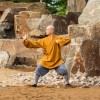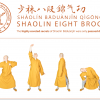What is Qi? (pronounced 'Chee')
Qi is simply another word for 'energy'. We release Qi (more accurately called Subtle Qi) in our body everytime we breathe.
There are 3 main categories of Qi: 1) Base Qi - the smallest particle of energy possible, 2) Subtle Qi - A combination of Base Qi that is a very delicate or light type of energy, and 3) Material Qi - A combination of Base Qi that produces the primary materials of our reality.
Science will tell you that when we breathe in, the air is filtered through our lungs and then enters the blood stream.
This then goes through our blood circulatory systems, enters the interstitial water system, to eventually reach millions of cells in the body.
Each cell will then consume the oxygen and surrounding carbohydrates, proteins, and other foods to release energy that is measured in a very minute scale called calories (not the same as the calories as you would find on a food package!).
It is this energy that the cell uses to carry out is functions (of healing and maintenance). It is also through this process that carbon dioxide is produced in our bodies which is then exhaled when we breathe out.
Science has gradually evolved to understand that our reality is made up of just energy.
It used to be thought that all matter was made of solid protons and neutrons with electrons.
Modern science now accepts that protons and neutrons are made up of even smaller sub-atomic particles of energy. So you see that solid desk of yours? It's moving at a smaller than sub-atomic level!
This means that everything we can touch, see, taste, hear and smell are all made of Qi. This is a powerful definition of Qi because it extends the possibilities of what Qigong can offer!
What is Shaolin Qigong?
Shaolin Qigong is the practice of energy awareness, cultivation, circulation, and development for a fruitful life.
These generally include soft, relaxing, and easy to do exercises such as practicing breathing techniques and forms that combine breath with movement to enhance circulatory systems.
One of the most important exercises in qigong is to develop the awareness and understanding of Qi.
We can write and talk about it all day, but it doesn't mean anything until you can feel it.
In other words, if you want to seriously learn Qigong, you need to become aware of Qi, be able to feel it, and experience its many variations.
Once you can feel it, you'll be able to grasp intermediate theory and develop your ability to cultivate it. This is where Net Qi comes into play and will become a future blog topic here.
When you are able to cultivate excess Qi, you'll be able to grasp advanced theory and learn how to move different kinds of Qi (called Subtle Qi) in the body.
Finally, it's important to note that the whole point of practicing Shaolin Qigong is to live a more fulfilled life.
This will mean something different for every person, but perhaps you will consider that a fruitful life means being able to enjoy the things you want to now and in your elderly years.
Qigong may very well be the most wholistic approach to enjoyment of life.
The Origin of Qigong
One of the oldest known forms of qigong may very well be from Shaolin.
Legends say that around 500 AD, a monk named Bhodhidharma settled at a temple that is known as the Shaolin Temple in Dengfeng, China.
When he passed away, he left behind a manual called Yijinjing which some have translated in English as Muscle Tendon Changing Classic.
This manual was then used by the monks to greatly increase their vitality and extend their martial arts capability.
While none of this can be scientifically proven through carbon-dated documents, we can see that in the past couple of decades, many variations of the Shaolin Baduanjin Qigong and Yijinjing forms have appeared, such as Taoist, Wudang, and other Qigong Organizations around the world.
They are similar and can certainly provide many of the same benefits.
|


















 YouTube
YouTube Instagram
Instagram Facebook
Facebook Discord
Discord